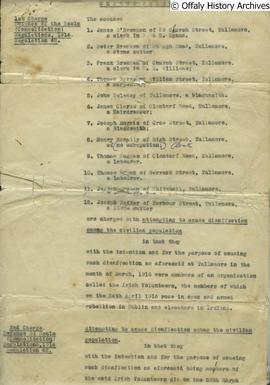Copies of approximately 1000 outgoing letters, averaging 1 per page. Good legibility.
Includes many references to the Tullamore 'affray' or Tullamore Incident, for example, letter to Tim M. Healy, M. P, House of Commons: '...I was immediately concerned with giving the facts in support of the point that the Competent Military Authority - Martial Law and the Defence of the Realm Regulations notwithstanding - noted without lawful authority in taking the prisoners out of Tullamore Gaol, that he has them illegally in his custody, and that the proposed trial by Court Martial will be illegal. ...It is entirely a case for a civil tribunal - for a jury; and on the evidence it is extremely unlikely that a jury anywhere would convict. It had not the most remote connection with the "Rising"; and to drag these men and boys before a Court of Military officers steeped in the atmosphere of the Insurrection and trotted out on the rebel stage a grave injustice - and is putting prisoners in serious danger.' (23 May 1916)
Elements area
Taxonomy
Code
Scope note(s)
- The Tullamore Incident refers to a breach of law and order on 20 March 1916 in Tullamore, Co. Offaly. It is frequently referred to as 'the first shots of the Rising' although it occured a month before the Easter Rebellion. A large crowd of locals whose family members were in the British army gathered outside the Gaelic League Rooms in Columcille St. protesting against the Irish Volunteers. Shots were fired by Volunteers Peadar Bracken, Frank O'Brennan and Joe Wrafter. RIC Sergeant Ahern was injured by Bracken. 12 men were subsequently charged in relation to the incident.
